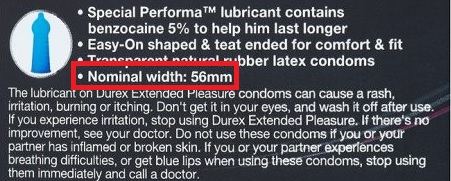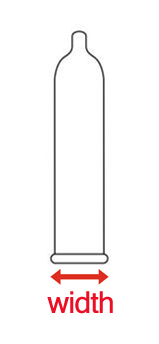Even though the term ‘nominal width’ is printed on the box of most brand name condoms, people seldom know what it means. That’s very unfortunate because it’s the key to achieving comfortable and secure fit.

We commonly use the word ‘nominal’ to refer to something that’s very small. It’s understandable that you might wrongly assume that nominal width is the measurement of the smallest part of the condom. In reality, the true meaning describes a stated dimension that doesn’t necessarily correspond exactly to the real value.
What actually matters, though, is that the condom will be too tight at the base if you choose a nominal width condom size that is too small. Likewise, condoms with overly large nominal width can easily slip, exposing both partners to sexually transmitted diseases.
How to Measure and Use Nominal Width
Nominal width is measured with the condom completely rolled out on a flat surface. Without stretching the condom in any way, place a ruler at the base (close to the rubber ring) and write down the measurement.

Nominal width itself isn’t actually of much use to us but we are able to use it to calculate what the circumference of the condom is. To find out, simply multiply the measured nominal width by two. For a typical 54mm (2.12″) wide condom, the circumference will be 108mm, or 4.25″.
To achieve the best fit possible, the circumference of the condom has to correspond to the circumference of your penis, while taking into consideration that latex condoms can stretch about 20% over their natural girth.
Without this stretching, condoms wouldn’t stay in place during intercourse. So, when we add 20% to 4.25″, we get 5.1″, which is the average girth of the penis. No matter what, avoid stretching any latex condoms farther than 20%. The condom would most likely survive, but you are exposing yourself to a completely unnecessary risk.
Don’t Let the Name Deceive You
Unfortunately, marketing sometimes takes precedence over reality. Many customers assume that Trojan Magnum XL are the largest condoms currently available on the market. Yes, their length of 205mm (8.1”) is decidedly above-average, but their nominal width is only 56mm (2.2″) which is just the same as other typical large condoms.
If you want condoms that are spacious in every way, you should, instead, purchase Durex Comfort XL or Durex XXL (look at the Durex condom size chart for more details). They are 215mm (8.5”) long and has a nominal width of 57mm (2.24″). If you need even larger condoms, take a look at TheyFit, a brand of condom sold in Europe. Lengths of their condoms are between 80mm to 240mm (3.1″ to 9.4″), and TheyFit condom widths are 41mm to 69mm (1.6″ to 2.7″).
Why don’t companies such as Trojan produce similarly large condoms? Because they legally can’t. The problem is that the FDA has set a minimum condom length, thickness, and maximum nominal width. The largest legal width is 57mm (2.2″), which means that these condoms have to stretch more than 23% for all men over 5.5″. Europeans also have restrictions on condom sizes, but the range is much wider: 41-69mm.
Conclusion
Nominal width is a critical measurement in determining whether a particular condom is suitable and comfort for you. It worth the time for you to do some research and find the perfect fit condom, again better size, better sex!
